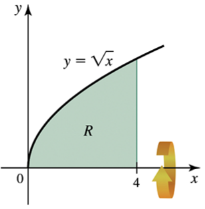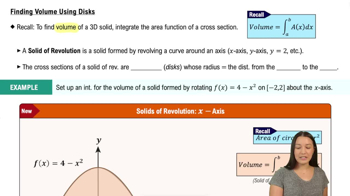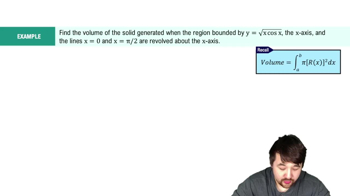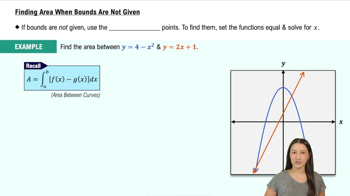Assume f and g are continuous, with f(x) ≥ g(x) ≥ 0 on [a, b]. The region bounded by the graphs of f and g and the lines x=a and x=b is revolved about the y-axis. Write the integral given by the shell method that equals the volume of the resulting solid.
Table of contents
- 0. Functions7h 54m
- Introduction to Functions16m
- Piecewise Functions10m
- Properties of Functions9m
- Common Functions1h 8m
- Transformations5m
- Combining Functions27m
- Exponent rules32m
- Exponential Functions28m
- Logarithmic Functions24m
- Properties of Logarithms36m
- Exponential & Logarithmic Equations35m
- Introduction to Trigonometric Functions38m
- Graphs of Trigonometric Functions44m
- Trigonometric Identities47m
- Inverse Trigonometric Functions48m
- 1. Limits and Continuity2h 2m
- 2. Intro to Derivatives1h 33m
- 3. Techniques of Differentiation3h 18m
- 4. Applications of Derivatives2h 38m
- 5. Graphical Applications of Derivatives6h 2m
- 6. Derivatives of Inverse, Exponential, & Logarithmic Functions2h 37m
- 7. Antiderivatives & Indefinite Integrals1h 26m
- 8. Definite Integrals4h 44m
- 9. Graphical Applications of Integrals2h 27m
- 10. Physics Applications of Integrals 3h 16m
- 11. Integrals of Inverse, Exponential, & Logarithmic Functions2h 34m
- 12. Techniques of Integration7h 41m
- 13. Intro to Differential Equations2h 55m
- 14. Sequences & Series5h 36m
- 15. Power Series2h 19m
- 16. Parametric Equations & Polar Coordinates7h 58m
9. Graphical Applications of Integrals
Introduction to Volume & Disk Method
Problem 6.4.13
Textbook Question
9-34. Shell method Let R be the region bounded by the following curves. Use the shell method to find the volume of the solid generated when R is revolved about indicated axis.

y = √x,y=0, and x=4; about the x-axis
 Verified step by step guidance
Verified step by step guidance1
Identify the region R bounded by the curves: \(y = \sqrt{x}\), \(y = 0\), and \(x = 4\). This region lies between the x-axis and the curve \(y = \sqrt{x}\) from \(x=0\) to \(x=4\).
Since the solid is generated by revolving the region R about the x-axis, and we are asked to use the shell method, we consider vertical shells parallel to the axis of revolution. However, the shell method is typically easier when revolving around the y-axis or a vertical line. Here, revolving around the x-axis, it is more natural to use shells in terms of \(y\).
Express \(x\) in terms of \(y\) from the curve \(y = \sqrt{x}\). Squaring both sides gives \(x = y^2\). The bounds for \(y\) are from \$0\( to \)2\( because when \)x=4\(, \)y=\sqrt{4}=2$.
The shell radius is the distance from the shell to the axis of rotation (x-axis), which is simply \(y\). The shell height is the horizontal length of the shell, which is from \(x=0\) to \(x=y^2\), so the height is \(y^2\).
Set up the volume integral using the shell method formula: \(V = 2\pi \int_{a}^{b} (\text{radius})(\text{height}) \, dy = 2\pi \int_0^2 y \cdot y^2 \, dy = 2\pi \int_0^2 y^3 \, dy\). This integral will give the volume of the solid.
 Verified video answer for a similar problem:
Verified video answer for a similar problem:This video solution was recommended by our tutors as helpful for the problem above
Video duration:
5mPlay a video:
Was this helpful?
Key Concepts
Here are the essential concepts you must grasp in order to answer the question correctly.
Shell Method for Volume
The shell method calculates the volume of a solid of revolution by integrating cylindrical shells. Each shell's volume is found by multiplying its circumference, height, and thickness. This method is especially useful when the axis of rotation is parallel to the axis of the function being integrated.
Recommended video:

Finding Volume Using Disks
Setting up the Integral with Respect to y
Since the region is revolved about the x-axis, and the shell method involves cylindrical shells perpendicular to the axis of rotation, the integral is set up with respect to y. The radius of each shell is the distance from y to the x-axis, and the height corresponds to the horizontal length of the region at that y-value.
Recommended video:

Integration by Parts for Definite Integrals Example 8
Understanding the Region Bounded by Curves
The region R is bounded by y = √x, y = 0, and x = 4. This defines a finite area under the curve y = √x from x = 0 to x = 4. Understanding these boundaries is essential to determine the limits of integration and the expressions for radius and height in the shell method.
Recommended video:

Finding Area When Bounds Are Not Given

 5:38m
5:38mWatch next
Master Introduction to Cross Sections with a bite sized video explanation from Patrick
Start learningRelated Videos
Related Practice
Textbook Question
9
views
